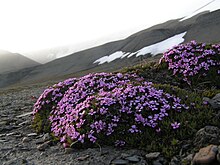
Silene is a genus of flowering plants in the family Caryophyllaceae. Containing nearly 900 species, it is the largest genus in the family. Common names include campion and catchfly. Many Silene species are widely distributed, particularly in the northern hemisphere.

Alpine tundra is a type of natural region or biome that does not contain trees because it is at high elevation, with an associated harsh climate. As the latitude of a location approaches the poles, the threshold elevation for alpine tundra gets lower until it reaches sea level, and alpine tundra merges with polar tundra.

Caryophyllaceae, commonly called the pink family or carnation family, is a family of flowering plants. It is included in the dicotyledon order Caryophyllales in the APG III system, alongside 33 other families, including Amaranthaceae, Cactaceae, and Polygonaceae. It is a large family, with 81 genera and about 2,625 known species.

The term subshrub or undershrub refers to either a small shrub or a perennial that is largely herbaceous but slightly woody at the base. "Subshrub" is often used interchangeably with "bush".

Oxyria digyna is a species of flowering plant in the buckwheat family (Polygonaceae). It is native to arctic regions and mountainous parts of the Northern Hemisphere.
There are over 190 vascular plant species on the Norwegian Arctic archipelago of Svalbard. This figure does not include algae, mosses, and lichens, which are non-vascular plants. For an island so far north, this number of species constitutes an astonishing variety of plant life. Because of the harsh climate and the short growing season, all the plants are slow growing. They seldom grow higher than 10 cm (4 in)

Silene dioica, known as red campion and red catchfly, is a herbaceous flowering plant in the family Caryophyllaceae, native to Europe and introduced to the Americas.

An Arctic–alpine taxon is one whose natural distribution includes the Arctic and more southerly mountain ranges, particularly the Alps. The presence of identical or similar taxa in both the tundra of the far north, and high mountain ranges much further south is testament to the similar environmental conditions found in the two locations. Arctic–alpine plants, for instance, must be adapted to the low temperatures, extremes of temperature, strong winds and short growing season; they are therefore typically low-growing and often form mats or cushions to reduce water loss through evapotranspiration.

A cushion plant is a compact, low-growing, mat-forming plant that is found in alpine, subalpine, arctic, or subarctic environments around the world. The term "cushion" is usually applied to woody plants that grow as spreading mats, are limited in height above the ground, have relatively large and deep tap roots, and have life histories adapted to slow growth in a nutrient-poor environment with delayed reproductivity and reproductive cycle adaptations. The plant form is an example of parallel or convergent evolution with species from many different plant families on different continents converging on the same evolutionary adaptations to endure the harsh environmental conditions.

Donatia novae-zelandiae is a species of mat-forming cushion plant, found only in New Zealand and Tasmania. Common names can include New Zealand Cushion or Snow Cushion, however Snow Cushion also refers to Iberis sempervirens. Donatia novae-zelandiae forms dense spirals of thick, leathery leaves, creating a hardy plant that typically exists in alpine and subalpine bioclimatic zones.

Silene scouleri is a species of flowering plant in the family Caryophyllaceae known by the common names simple campion and Scouler's catchfly.
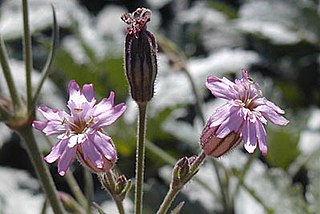
Silene verecunda is a species of flowering plant in the family Caryophyllaceae known by the common name San Francisco campion.

Astragalus molybdenus is a species of flowering plant in the legume family known by the common names Leadville milkvetch and molybdenum milkvetch. It is endemic to Colorado in the United States. If the separate species Astragalus shultziorum and Astragalus lackschewitzii are included in A. molybdenum the range expands into Wyoming and Montana.
Draba graminea is a species of flowering plant in the mustard family known by the common names Rocky Mountain draba and San Juan Whitlow-grass. It is endemic to the state of Colorado in the United States, where it is limited to the San Juan Mountains.
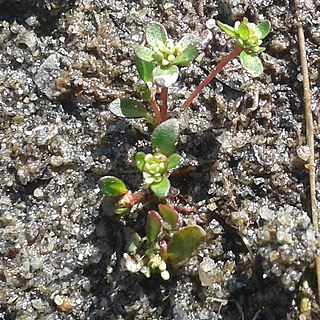
Koenigia islandica is a species of annual flowering plant in the buckwheat family, Polygonaceae and is the type species of the genus Koenigia. It is a very small plant and is found growing on wet gravel and scree in arctic tundra and alpine meadows.
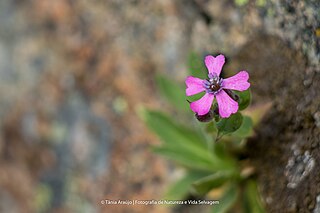
Silene acutifolia is a species of herb native to northwest Spain as well as central and northern Portugal. The species is polycarpic and usually grows in rocky environments.
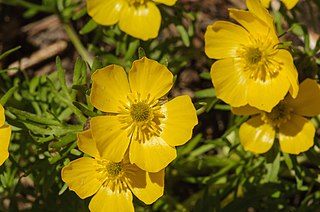
Ranunculus adoneus, the alpine buttercup or snow buttercup, is a species of flowering plant. It is an alpine buttercup from the family Ranunculaceae. This species is mainly found in the Rocky Mountains in Colorado and Wyoming but can also be found in Idaho, northern Utah and eastern Nevada. Its typical habitat is short grass meadows near the edge of melting snow.
